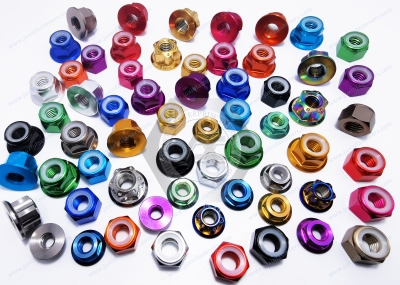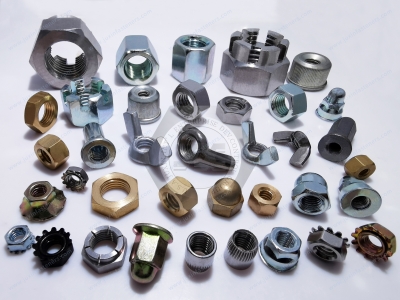Call Us
+86 136 6007 9809
Call Us
+86 136 6007 9809
Jan. 22, 2024
A high-strength nut is a high-strength bolt, which is a standardized part. Generally, high-strength bolts can withstand greater loads than ordinary bolts of the same size.
What is a high-strength nut?
A high-strength nut's shape and connection structure are identical to an ordinary bolt's. The main difference between the two is that: a familiar bolt connection relies on the bar's compression and shear to transmit shear strength, and the pre-tension strength of the bolt when torquing the nut is minimal, and its effect is not considered; the working principle of a high-strength nut connection is to intentionally apply a large amount of pre-tension strength to the bolt, so that the connection contact surfaces create a compression strength and thus there is a large friction force perpendicular to the direction of the screw, and this friction force is relied on to transmit connection strength. This results in a high degree of friction perpendicular to the screw, which is relied upon to send the shear strength of the connection. The pre-strength of a high-strength nut is achieved by torquing the nut. The torque and turn methods are generally used for regular high-strength nuts. In the case of torque-shear type high-strength nuts, the pre-strength is controlled by twisting off the end of the bolt.
Bolts for high-strength nut connections are made from high-quality alloy structural steel, grade 10.9S or 8.8S, and heat-treated, and holes for high-strength bolts are drilled. The hole diameter of high-strength bolts for friction-type connections is 1.5 to 2.0 mm larger than the nominal bolt diameter d; the hole diameter of high-strength bolts for compression-type connections is 1.0 to 1.5 mm larger than the little bolt diameter d.
1. A high-strength nut connection has the advantages of simple construction, good stress performance, removable, fatigue resistance, and the action of dynamic load will not l, loosen, etc. It is an up-and-coming connection method.
2. A high-strength nut is a special wrench used to tighten the nut so that the bolt produces a vast and controlled pre-tension through the nut and pad, the same size as the connected parts of the pre-pressure. Under pre-pressure, along the surface of the related parts will produce greater friction; as long as the axial force is less than this friction, the components will not slip, and the connection will not be damaged; this is the principle of a high-strength nut connection.
3. High-strength nut connection relies on friction between the contact surfaces of the connecting parts to prevent their mutual slippage. To make the contact surfaces have enough friction, it is necessary to improve the clamping force of the components and increase the friction coefficient of the contact surfaces of the elements. The clamping force between the components is applied pre-tension to the bolt to realize, so the bolt must be made of high-strength steel, also known as a high-strength bolt connection.
High-strength bolt connection, the size of the coefficient of friction on the bearing capacity of the significant influence. Tests show that the coefficient of friction is mainly affected by the form of the contact surface and the material of the component. To increase the coefficient of friction of the contact surface, the construction often used should be sandblasted, cleaned up with a wire brush, and other methods of connecting the range of components contact surface treatment.
4. High-strength nuts have friction and pressure types. There are two kinds. Friction-type high-strength bolts to withstand shear guidelines are the design load caused by the shear force that does not exceed the friction. Pressurized high-strength bolts are not sheared, and the body or plate is not crushed according to the design guidelines.
In addition, high-strength bolts cannot be reused.
Classification of high-strength nuts
1. According to the state of strength: friction type and compression type: there is a difference in the design calculation methodology, where friction type high strength nuts use the occurrence of sliding between the plates as the limit of strength, and compression type high strength nuts use the occurrence of sliding between the plates as the limit of everyday use, and breakage of the connection as the limit of strength. Friction-type high-strength nuts do not utilize the full potential of the bolt. In practice, friction-type high-strength bolts should be used for critical structures or structures subjected to dynamic loading, especially if the loading causes back-power, where the unused potential of the bolt can be used as a safety reserve. Otherwise, pressure-type high-strength nuts should be used to reduce the cost.
2. According to artistry, two high-strength nuts are twisted-shear type high-strength nuts and macro hexagonal high-strength nuts.
While the high-strength massively hexagonal high-strength nuts belong to the high-strength class of standard screws, the twisted-shear high-strength nuts are an improved version of the massively hexagonal high-strength nuts for better artistry. High-strength nuts must be torqued initially and then torqued finally. Initial torquing of high-strength nuts requires an impact electric or torque-adjustable electric wrench. In contrast, the final torquing of high-strength nuts has strict requirements and torque-shear electric wrenches are necessary for the final torquing of torqued-high-strength nuts and torque electric wrenches are required for final torquing of torqued-high-strength nuts.
A sizeable hexagonal bolt consists of a nut and two washers. Torque-type high-strength nuts consist of one bolt, nut, and washer.
3. Difference between high-strength nuts: Generally, high-strength bolts can bear a more significant load than ordinary bolts of the exact specification.
Ordinary bolts are made of Q235 (i.e., A3).
High-strength bolts are made of 45# steel, alloy steel (e.g., 20MnTiB, 35VB), or other high-quality materials and are heat-treated after fabrication to increase their strength.
The difference between the two is the strength of the material.
4. Raw materials: High-strength bolts are manufactured from high-strength materials. The screw, nut, and washer of a high-strength nut are made of high-strength steel, often 45-gauge, 40-boron, 20-manganese-titanium-boron steel. Ordinary bolts are usually made of Q235 steel.
5. Strength class: High-strength nuts are increasingly used. Two strength grades, 8.8 and 10.9, are often used, with 10.9 being the most common. The strength grades of ordinary bolts are lower, generally 4.4, 4.8, and 5.6. (8.8S and 10.9S are used exclusively for steel structures.


The main features of high-strength nuts are as follows:
1. Easy to install, integrity, and dismantle, reusable medium carbon steel used for manufacturing materials. The connection structure is simple and has good mechanical properties, disassembly, fatigue resistance, and no loosening during dynamic loading. This is an up-and-coming connection method.
2, high-strength nuts are used to tighten special wrench nuts so that the bolt through the nut and buffer plate produces a vast and controlled pre-tension; the same size pre-pressure is applied on the joint. Under the effect of preload, there is greater friction along the connector surface. If the axial force is less than the friction, the parts will not slide, and the connection will not be broken. This is the principle of high-strength nut connection.
3, high-strength nuts are steel used for fasteners with high interchangeability produced through the cold heading process. Because it is formed by metal-plastic processing at room temperature, the deformation of each part is large, and the deformation rate is high. Therefore, the performance requirements of raw materials for high-strength nuts are stringent.
If you are looking for high-quality nuts fasteners or technical support for structural design, you are welcome to contact me. Thanks.Email:adelajonly@gmail.com
Website: https://www.juxinfasteners.com
Contact Us
Tel.:
+86 020 8621 0320
+86 020 3121 6067
Technical Support:
Navigation
SEND INQUIREY